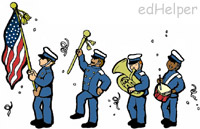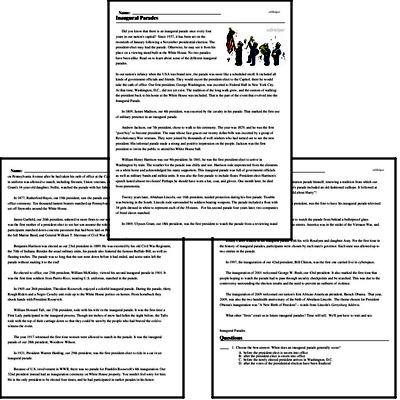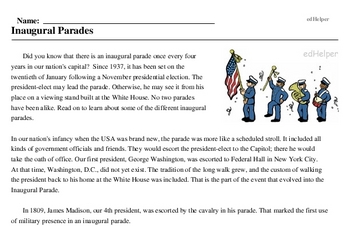Inaugural Parades
Inauguration Day
Reading Comprehension for January 20
Did you know that there is an inaugural parade once every four years in our nation's capital? Since 1937, it has been set on the twentieth of January following a November presidential election. The president-elect may lead the parade. Otherwise, he may see it from his place on a viewing stand built at the White House. No two parades have been alike. Read on to learn about some of the different inaugural parades.
In our nation's infancy when the USA was brand new, the parade was more like a scheduled stroll. It included all kinds of government officials and friends. They would escort the president-elect to the Capitol; there he would take the oath of office. Our first president, George Washington, was escorted to Federal Hall in New York City. At that time, Washington, D.C., did not yet exist. The tradition of the long walk grew, and the custom of walking the president back to his home at the White House was included. That is the part of the event that evolved into the Inaugural Parade.
In 1809, James Madison, our 4th president, was escorted by the cavalry in his parade. That marked the first use of military presence in an inaugural parade.
Andrew Jackson, our 7th president, chose to walk to his ceremony. The year was 1829, and he was the first "poor boy" to become president. The man whose face graces our twenty dollar bills was escorted by a group of Revolutionary War veterans. They were joined by thousands of well-wishers who had turned out to see the new president. His informal parade made a strong and positive impression on the people. Jackson was the first president to invite the public to attend his White House ball.
William Henry Harrison was our 9th president. In 1841, he was the first president-elect to arrive in Washington by train. The weather for the parade was chilly and wet. Harrison rode unprotected from the elements on a white horse and acknowledged his many supporters. This inaugural parade was full of government officials as well as military bands and militia units. It was also the first parade to include floats. President-elect Harrison's speech lasted almost two hours! Perhaps he should have worn a hat, coat, and gloves. One month later, he died from pneumonia.
Twenty years later, Abraham Lincoln, our 16th president, needed protection during his first parade. Trouble was brewing in the South. Lincoln rode surrounded by soldiers bearing weapons. The parade included a float with 34 girls dressed in white to represent each of the 34 states. For his second parade four years later, two companies of freed slaves marched.
In 1869, Ulysses Grant, our 18th president, was the first president to watch the parade from a reviewing stand on Pennsylvania Avenue after he had taken his oath of office at the Capitol. Almost any group that came dressed in uniform was allowed to march, including firemen, Union veterans, and a variety of members of men's clubs. Grant's 14-year-old daughter, Nellie, watched the parade with her father.
In 1877, Rutherford Hayes, our 19th president, saw the parade established as a separate event from the oath of office ceremony. Ten thousand lantern bearers marched up Pennsylvania Avenue. They sang campaign songs and set off fireworks around the White House.




